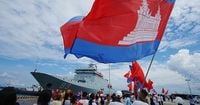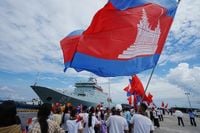On Friday, October 10, 2025, the port city of Sihanoukville, Cambodia, became the focal point of regional attention as two Chinese warships—the amphibious warfare ship Yimeng Shan and the training ship Qijiguang—arrived for what Beijing described as a friendship and training visit. The timing, however, could hardly be more delicate. The region is still unsettled by a recent five-day armed conflict between Cambodia and Thailand in late July over a disputed border area, and China’s increasing involvement in Cambodia’s defense affairs has only added to the diplomatic unease swirling through Southeast Asia.
The ships, which docked at Sihanoukville’s civilian port on the Gulf of Thailand, are scheduled to depart on Tuesday, October 14, 2025, continuing their journey with planned stops in Thailand and Singapore. According to the Associated Press, Chinese officials have emphasized that the visit is not intended as a show of support for Cambodia in its ongoing border dispute with Thailand. Instead, Sam Sokha, a spokesperson for the Cambodian navy, explained on Wednesday, “the main goal of the visit is to strengthen cooperation,” underscoring that the warships’ presence should not be interpreted as taking sides in the territorial squabble.
Yet, the optics are hard to ignore. China’s supply of weaponry to Cambodia has already ruffled feathers in Thailand, and the presence of Chinese warships—even under the banner of friendship—raises questions about Beijing’s broader ambitions in the region. The decision to dock at the civilian port rather than the nearby Ream Naval Base appears calculated to ease political tensions. The Ream base, after all, has been at the center of controversy for years. The United States has long suspected that China’s funding of a sweeping expansion project at Ream has come with secret privileges for Beijing, potentially granting the Chinese military a foothold in the strategically vital Gulf of Thailand. Both Cambodian and Chinese officials have repeatedly denied these allegations.
Rear Adm. In Sokhemra, deputy chief of the Ream Naval Base, was on hand to welcome the Chinese visitors. He sought to place the occasion in a broader context, telling journalists, “Every year foreign ships often come to Sihanoukville in Cambodia to conduct cooperative exercises and to strengthen friendship and solidarity, whether from China, the Philippines, Australia or the United States.” It’s not just talk: on the very same day, the Australian Navy’s frigate HMAS Ballarat docked about 500 meters away from the Chinese vessels. The Ballarat is part of what the Australian Defence Force calls a “Regional Presence Deployment,” a mission that includes port visits and military exercises with partner nations to demonstrate Australia’s commitment to a secure, stable, and prosperous Indo-Pacific region. During its current voyage, the Ballarat has already conducted exercises with Brunei, Malaysia, New Zealand, Singapore, the United Kingdom, and the United States.
For China, the visit is part of a broader strategy to maintain and deepen alliances with Southeast Asian nations. As reported by Devdiscourse, Beijing’s relationship with Cambodia is increasingly crucial at a time of regional diplomatic unrest. The Gulf of Thailand, adjacent to the South China Sea—an area China claims almost in its entirety—offers expedited access to the Malacca Strait, one of the world’s most important shipping lanes. China’s growing naval presence in these waters is, therefore, not just about friendship; it’s about positioning itself as a key player in the geopolitical landscape of Southeast Asia and maintaining influence over critical maritime routes.
Chinese Ambassador to Cambodia Wang Wenbin weighed in with a statement posted to Facebook on Wednesday, October 8, 2025. He wrote, “China firmly supports Cambodia in safeguarding its national sovereignty, security and development interests, and will always be a reliable partner in Cambodia’s development.” The ambassador’s words, while not directly referencing the warships’ visit, echoed Beijing’s consistent messaging about its intentions in the region. Still, for some observers, the timing and symbolism of the visit speak volumes about China’s growing clout and the careful diplomatic dance underway between regional powers.
The arrival of the Chinese ships was met with considerable fanfare. A large crowd, including many ethnic Chinese civilians, gathered at the port to welcome the sailors. Amid the waving of Chinese flags and placards written in Chinese, a traditional dragon dance was performed as the captain of one of the ships disembarked. These festivities underscored the strong social and economic ties between China and Sihanoukville—a city that has, in recent years, become a magnet for Chinese investment. But the relationship is not without its darker sides. Sihanoukville has also gained notoriety as a hub for Chinese-run criminal enterprises, particularly scam centers that perpetrate large-scale online fraud. These operations are often staffed by foreigners who have been lured to Cambodia under false pretenses and then held captive, according to multiple reports from the Associated Press.
Despite the celebratory atmosphere, some residents and regional analysts remain wary. The unresolved border dispute between Cambodia and Thailand continues to cast a shadow, and China’s role as both an arms supplier and a close ally to Cambodia is a source of unease for Bangkok. The Thai government has expressed irritation over Beijing’s military support for Phnom Penh, and the ongoing tensions have left the border situation fragile. The fact that the Chinese navy’s visit comes so soon after open hostilities between Cambodia and Thailand underscores the complex web of alliances and rivalries that define Southeast Asian geopolitics.
Meanwhile, Western governments—particularly the United States—are watching closely. Washington’s concerns about the Ream Naval Base are rooted in the fear that China could use the facility to project military power deeper into the region, potentially threatening the balance of power in the South China Sea and beyond. Cambodian officials, for their part, insist that no such arrangement exists and that their partnership with China is focused on development and mutual security rather than exclusive military privileges.
As the Chinese warships prepare to continue their journey to Thailand and Singapore, the visit leaves behind a mixture of celebration, suspicion, and unresolved questions. For Cambodia, the event is a reminder of its deepening ties to China and the benefits—and challenges—that come with that relationship. For the region, it is yet another sign that the strategic contest for influence in Southeast Asia is far from settled, and that the waters off Sihanoukville will remain a stage for both cooperation and competition in the years ahead.
For now, the dragon dancers have departed, the ships are preparing to move on, and the diplomatic balancing act across Southeast Asia continues—its outcome as unpredictable as the shifting tides on the Gulf of Thailand.





